Question: How do I get rid of a cyst?
Answer:
Basic Method for Treating a Cystic Pimple
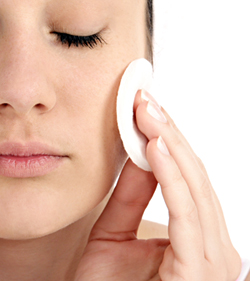
The best way to treat a cyst is to put a warm compress on it several times a day (a tip from my aesthetician). You don’t want to use very hot water, but water at a temperature in between hot and lukewarm where you can dip your finger in the water and barely feel any discomfort.
What you do is basically soak a clean towel, cotton ball, or sponge in warm water and apply to the cyst until the towel, cotton ball, or sponge loses heat. When it cools off, re-soak in warm water (tip: re-heat the water in microwave, but make sure it's not scalding hot!) and reapply the compress to the cyst. Keep doing this for as much time as you have and for as many times as you can throughout the day. It can get pretty boring just sitting there holding something to your face, but it’s really worth it because this method will cut a cyst’s lifespan in half.Alternatively, instead of using a cotton ball and warm water for the warm compress, here are instructions for making a cheap and easy "rice sock" warm compress that holds heat better than a wet sponge and is less messy to use.
How does a warm compress work for acne?
The warm compress works by killing bacteria and reducing inflammation. My aesthetician says that the heat also helps emulsify the sebum trapped inside your pore so the cyst comes to a head faster. However, even if the cyst looks like it has a white head, it’s still better to not pop it. Squeezing a pimple usually pushes the clog deeper and makes the cyst even worse.
Do not pop, poke, or squeeze!
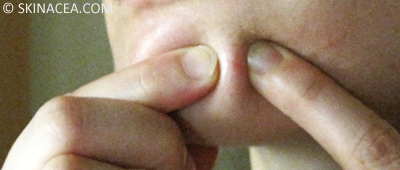
There are some people who use a lancet or small knife to cut into a cyst and fish out the clogged part of the pore. While I do concede that removing the root of a pimple will help it heal or flatten faster, cutting open a cyst is extremely risky. You not only run the risk of getting an infection, but you also run the risk of scarring, as in a permanent skin indentation or protrusion.
And what if you cut open a cyst but can't squeeze out the root clog? You don't know where the root is or how deep it resides inside your skin. You can't even be 100% confident that you will be able to completely remove the hardened plug of the cyst. If any remnants of the clog remain, the cyst is likely to get re-inflamed and come back even worse. It's also not exactly good to cut open skin and dig around and squeeze the wound. Doing so will only make a bloody mess, increase the chance of skin scarring, and prolong the time it takes the cyst to heal.
Cysts are big and sore to the touch because they are much deeper infections in your skin. You usually will not be able to successfully drain a cyst without causing even more damage because it has spread through too many layers of your skin. All you can really do is apply a warm compress and wait until it shrinks.
Sometimes, if a cyst has shrunken in size and downgraded to a smaller, inflamed pimple with a yellow pus-filled head, it’s okay to extract it. However, it’s still best to keep your hands off your face because if you poke a cyst, it will poke back!
Other methods for treating a cyst
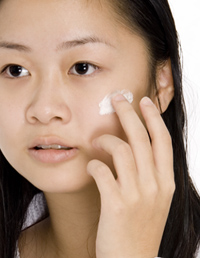
Using warm salt water instead of plain water for the compress can also bring the cyst to head faster. However, the salt water can be irritating and drying, especially if you apply it many times in one sitting. I have also heard that putting baking soda or egg white on a cyst will help draw it out. However, nothing I have ever used has worked as well as a simple warm compress with a dose of patience.
Catching cysts or other inflamed pimples when they first form will help them go away faster. If you start using the warm compress method on a cyst that is just budding, you may even be able to stop it in its tracks and prevent it from growing into a full-blown cyst. You can usually tell when you are going to get a cyst when a small bump on your face starts to hurt deep in your skin and feel sore.Spot treating a cyst with an acne treatment of some sort may also be beneficial. Depending on how harsh the treatment is, you could end up drying the top layer of skin on the cyst but not really do much else to reduce the inflammation. I used to dab Differin on my cysts, but I realized that it always caused the top of the cyst to peel off, leaving the rest of the cyst completely intact but red and raw.
Nowadays when I do get a cyst, I skip the topical spot treatments (because my skin is sensitive and dry) and apply a warm compress as many times as possible. When I'm not using a warm compress, I cover up the cyst with a band-aid or some DuoDerm synthetic skin dressing. I'm not sure if the synthetic skin dressing does anything to calm the cyst down, but it makes me forget about how big the cyst actually is and it discourages me from touching, squeezing, or trying to pop the cyst, which are all the things you can do to make a cyst worse.
What about hemorrhoid cream?
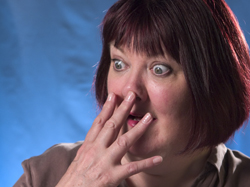
Another thing you can use to treat a cystic pimple is hemorrhoid cream. I know, it's not the most appealing product to put on your skin, but people claim hemorrhoid cream can shrink a cyst within a day because it helps to shrink swelling and reduce inflammation in... other areas.
To be honest, I actually tried this method. The first time I used hemorrhoid cream for a cyst, it really worked. By the next day, the cyst was much smaller and much less painful. I thought I found my holy grail cyst treatment, but this newfound joy did not last very long.
When I tried using hemorrhoid cream on my future cysts (which I had plenty of), it did absolutely nothing. I even went out and bought different brands, but the cream never worked for my cysts after that one successful time. I'm not entirely sure why. Maybe that first cyst was already going to shrink on its own, who knows. But if you decide to give hemorrhoid cream a try, make sure you read about the potential side effects and risks of using the product out of context.
Dermatologist shot for immediate shrinkage
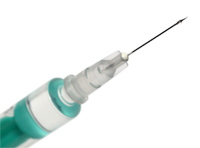
Doing the above things should help you get rid of a cyst in about 7 to 10 days, if not sooner. However, if you need or want the cyst gone by the next day, a dermatologist can give you a cortisone or steroid shot. This will shrink the cyst immediately, with some lingering redness.
However, you want to be careful when you are getting these kinds of shots because they could potentially cause indentations in your skin. They are also expensive and not everyone can afford to get them.
Lingering bump from a cyst?
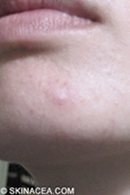
Sometimes as a cyst heals and is no longer inflamed, it will leave behind a dark colored bump (not to be confused with keloids). This bump doesn't hurt when you touch it, but when you touch your face, you can definitely feel something leftover from the cyst. It's not like a blackhead where you can extract it because the root of the "bump" is too deep inside your skin. I like to call these kinds of non-inflamed, post-cystic pimple bumps "dormant cysts."
The best thing to do when treating these lingering effects of a cyst is to: 1) not poke or squeeze and 2) exfoliate often (but not to the point of irritation). If you try to squeeze whatever gunk is left inside your skin to help push it out faster, you will end up angering your skin even more. Best case scenario, your skin is red for a few hours. Worst case scenario? The original cyst comes back full force and leaves a scar. Whatever dark mark left over from the cyst will then take even longer to fade.
Instead of picking or squeezing to get the bump out of the dormant cyst, exfoliate the bump to speed up your skin's shedding in order to bring the plug closer to the surface so your skin can push it out on its own. Manual exfoliation works (as long as you don't over scrub), as well as chemical exfoliants such as BHA and AHA.
These kinds of post-cyst bumps tend to stay around for awhile. They can linger for as short as a week or as long as 2-3 months. I had one in my right cheek that took 6 months to completely go away! This was probably just a strange case, but everyone's skin is different so there is no definitive time table for when these types of bumps will clear.
What usually happens is, as you exfoliate the bump, you will notice smaller pimples and blemishes start to crop up around the bump. The bump itself might turn back into an inflamed pimple, but not as severe as a full-blown cyst. This is all taking place because your skin is trying its hardest to push out the clog. Until the entire root is pushed out of your skin, the bump will not go anywhere.
While it's tempting to use brute force to help your skin push out the bump faster, from personal experience, no good will come from doing so. Treating the after-effects of a cyst will take a lot of time and patience, but it can be done!
Scarring and pitting from a cyst
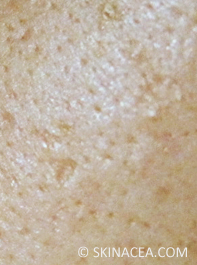
Besides leftover painless bumps, cysts can also leave behind scarring and pitting. This usually happens when you pick and squeeze at the spot. Sometimes though, even if you leave the cyst completely alone, your skin will scar for no reason other than because it's your skin.
It sucks, I know. Preventing scarring is the best treatment for acne scarring, but to prevent scarring, you first have to prevent acne, which really isn't that easy of a job to begin with.If you experience scarring from a cyst, you can try aggressive procedures such as deep chemical peels and facial lasers. With these kinds of treatments, a 30% improvement in the appearance of scars is considered a good result. In other words, acne scars are really hard to treat and even the most aggressive and expensive procedures yield disappointing results.
You can also try using retinoids to "thicken" up your skin and plump up any pitting to make them less noticeable. However, this takes time and results are not guaranteed. Professional dermarolling is another method for smoothing out skin, but I have never tried this before nor met anyone who has tried it and found it to work. Unfortunately, acne scars are just super stubborn and resistant to treatment.
If all else fails, a cosmetic way (besides using make up primer) to improve the appearance of indented acne scars is to fill them in with silicone microdroplets. A few dermatologists and plastic surgeons offer this procedure to improve skin texture, though this is different from facial rejuvenation procedures, which usually have a minimal effect on acne scarring. Tiny silicone microdroplets are injected into individual indented scars to plump them up. Treated areas might scab and stay red for some time before fading. Silicone microdroplets do not make acne scars go away 100%, but compared to other acne scar treatments, they seem to have the best results.
Conclusion
Unfortunately, the best way to treat a cyst is to prevent them in the first place. And to prevent cysts, you need to figure out the underlying reason for your acne. Usually though, cysts are related to something internal - whether it's hormonal imbalances or food sensitivities.
Cysts are a big pain (literally and figuratively). Hopefully you won’t have too many of them to deal with in the future and if you do, hopefully the above information for getting rid of a cyst will help your cyst go away faster.
Last updated: August 29, 2012
FAQ: Does popping pimples make them go away faster?
Back « Skin FAQ
Related articles:
- Acne Face Map
- Acne Treatment List
- How I Cleared My Skin
- My Before and After Acne Pictures
- What is Your Skin Type
